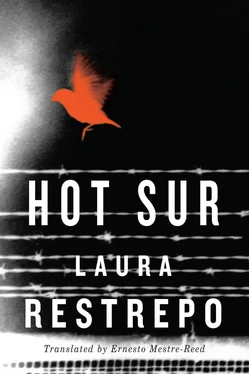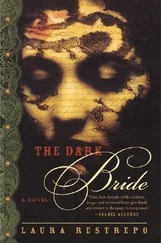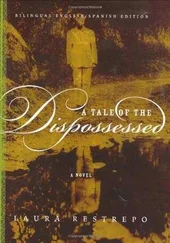There was another suggestive detail, similarly revealing. To be able to fit everyone in the photo, members of the family had bunched together. Yet none of them touched another; instead they were separated by tiny spaces that signaled the harsh loneliness of each figure. The exception again was the boy Joe, resting confidently on his mother’s knees. That child was not afraid of his mother; on the contrary, it would seem he took refuge in her against the others.
“No doubt there was something lovely about the woman,” Rose tells me. “A battered loveliness, almost destroyed by the husband’s merciless beatings, the marks evident on the children as well.”
According to María Paz, the woman was just someone who lived murmuring prayers and rarely bathed, but her character gained some depth with the details supplied by Wendy Mellons. Her name was Danika Draha, and she wore her hair in a braid tight and stout as a rope. She was perennially pining for the mountain country she had left behind in her homeland, because she was convinced that it was through those forests that one reached heaven. There were no signs that she missed her parents or her siblings, but the longing for those mountains often made her weep, and it was impossible for her to adjust to the landscape of Colorado. Since coming to the New World, everything in her life had been vulgar, sad, and ugly. Everything except her youngest son, the bright and beautiful boy whom she had not named Joe (that nickname came later, and she had never approved of it) but Jaromil, which in their language meant spring. In that creature, she invested all her affections, and she lived to please him. According to Wendy Mellons, little Jaromil was the only green branch in the withered tree that Danika Draha had become.
“Jaromil. That was Sleepy Joe’s real name,” Rose tells me. “And no doubt how he must be listed as such in his official documents.”
Mother and son prayed together, visited the church daily, fasted, painted Easter eggs, in December put up the Nativity scene, and during Holy Week were always in the first row for the reenactment of the Crucifixion that the Latinos in town put on every year. Liturgy by liturgy, they forged a religion in common as a sort of homeland in common, apart from the rest of the tribe — a world of its own made of candles, silicon, cassocks, confessionals, prodigious saints, sacrifice and redemption, blood, miracles, alms, and chanting. The mother was so attached to the child that she breastfed him until he was nine years old. “You’re sucking the life out of her,” the father said to his youngest every time he saw the boy latched on to the breast, and beat him away. On the death of the mother, the father laid the entire blame on the coddled child, the favorite, the spoiled one. The youngest. “He sucked the life right out,” he told anyone who would listen, “this dastardly child sucked and sucked on my wife till there was no life left in her.”
“The tragedy for Jaromil began with her death,” Wendy Mellons told Rose. “Imagine the loneliness of that child who went from being the light of his mother’s eyes to the most insignificant one in the home, which was no longer a home, because no one ever again provided or cared for the children or hardly fed them. One by one, the sons soon disappeared to find work and a life in the world. None of them could tolerate the drunkenness and anger of the father for long. The daughters also left as they quickly married, which wasn’t hard since white healthy flesh was coveted and in demand. Greg, the oldest, stayed behind to watch over the youngest, until he too eventually left. He went off to become a cop and did not reappear till years later. And Jaromil? Under the bed, in a ditch, in the top of a tree. He learned to hide every time the father came home, to avoid the ridiculing and the beatings.”
At some point in his childhood, Sleepy Joe understood that he could use the mystical to protect himself, or maybe he immersed himself in the mystical traditions learned from his mother. He went into a trance every time the priest raised the Host at Mass. His eyes rolled back in his head during these outbursts of love for God. He remained in the trance for minutes; no one could shake him or pinch him out of it, hence the nickname he acquired about this time: Sleepy Joe, in tandem with the reputation that came after a handful of these episodes. His looks didn’t hurt. From the time he was a little boy, he was pretty and alluring, like a little Jesus, people said, especially because of the blond curls cascading on his shoulders. His father, however, was not moved by his curls, and he made Sleepy Joe’s life impossible, telling him he was nothing but a prissy little girl. The townspeople’s reactions were very different, though. A few of them began to whisper that he was a holy child, others that he was suffering from some mysterious illness. Eventually most of them began isolating themselves from him, because they believed he was an instrument of bad luck.
“One thing is for sure,” Wendy Mellons told Rose, “if they had not ruined that boy’s religious career, he would have become the pope, because he did not lack fervor and dedication, which he still has to this day. But they blocked him from his destiny and messed everything up. When the whites cast him aside, he sought to ingratiate himself with the Latinos, but they too rejected him. In the end, the only ones who remained true to him were us, the whores, and he grew up among us.”
The brothel became his refuge. There he could be king again. Because he was so pretty, the girls fought over who would tend to him, comb his hair, hand feed him. They didn’t charge him when he was old enough to have sex with them and even provided him with spending money, because he was their pet, their precious doll, their pretty little boyfriend. And what else could come of such coddling? Joe got used to living off them, sweet-talked them to get what he wanted, threw temper tantrums if they denied him something, always knowing that in the end anything he did would be tolerated. Wendy Mellons explained that Sleepy Joe’s gift was to take from others as if every day was his last day on earth. Eventually things got complicated. The girls started to complain about his brutality and the cruel names he called them; they tired of hearing that they were nothing but sows and scavengers and evil bitches. He accused them of living in sin, and hated them for making him sin. He adored them and loathed them, and could only resolve this contradiction by resorting to threats and violence. The last straw came when he put a match to the translucent and highly flammable nightgown of one of the girls named Tinker Bell, who wasn’t burned alive, by the grace of God, but it left her with permanent scars.
“He’s a horrible man but at the same time always very repentant about his actions,” Wendy Mellons tried to explain to Rose. “He didn’t want to sin — not out of love for his neighbor, but because he was terrified of the eternal punishment. Always very angry, that’s for sure, at everything and everyone. There is a very sick side in him. Disturbed since childhood. And yet, I still love him like a son.”
“So are you still close to him?” Rose ventured, intuiting that this woman could serve as bridge to him.
“Close? Yes,” she said. “As close as he allows anyone to get to him.”
“Are you in touch with him? Do you see him?” María Paz blurted out, perhaps out of jealousy.
“Do I see him in person, you mean?” Wendy Mellons countered, and to prove her case without having to answer these questions, she pulled out a photograph from a drawer. “Taken very recently,” she said.
It had been taken with a Polaroid and, as she said, had to be somewhat recent, because Wendy Mellons did not seem any older than she was that day, even if in the picture she wore a sunhat festooned in flowers as if she were British royalty. It was a full-body shot, and she had her arms around a drifter type in jeans and a tank top, his face half hidden under Ray-Ban Aviators and a ten-gallon hat. The exposed portion of his face showed bruised lips and an imposing square chin. Rose could not connect the little Sleepy Joe in the first photograph they had seen with this moron in sunglasses with the brim of his hat pulled low. But María Paz said in an assured voice, “That’s him.” The couple in the picture leaned on the hood of a medium-size yellow truck, maybe a Dodge Fargo or a Chevrolet Apache. On the top part of the windshield, there was a transparent sticker with a message in iridescent letters. It read “Gift from God.”
Читать дальше












